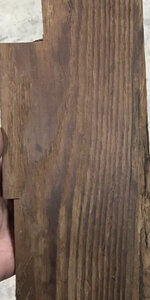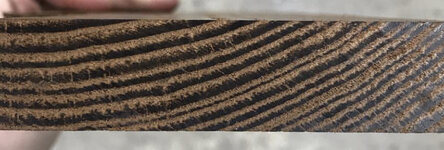You are using an out of date browser. It may not display this or other websites correctly.
You should upgrade or use an alternative browser.
You should upgrade or use an alternative browser.
Can anyone help identify this wood?
- Thread starter albwdb
- Start date
Signed-In Members Don't See This Ad
Signed-In Members Don't See This Ad
Curly
Member
Is that a thermally treated wood? Caramelized ash maybe? Or a Bog ash/elm? Not oak because there are no medullary rays.
dogcatcher
Member
I would guess ziricote wood. Polishes up real good.
mark james
IAP Collection, Curator
gimpy
Member
My thoughts Exactly
I'm going to say thermally modified, maybe ash. IMHO, the darks are too light (brown) to be wenge and the end grain is a little off. If you have any information about the history of the wood or potential source, that might help narrow things down.
jttheclockman
Member
Black locust maybe. Is it a hardwood or softwood?? Is the wood from your area?? Has the wood been treated?? Where did you get the wood from. Is there any smell??? Is it heavy or light?? As you see there are way too many unanswered questions even to guess and that is ll we are doing. We need more info whenever you ask questions like this. Do you know how many species of wood there are?? Many to say the least.:biggrin:
Last edited:
leehljp
Member Liaison
Kinda reminds me of aged barn wood Sassafras. this link shows it as a lighter colored wood but the sassafras that I have had was much darker than the ones in the link:
https://www.wood-database.com/sassafras/
The end grain looks the same as yours.
Aged Black Ash is my second choice. One thing that should be noted is that it sure looks aged or thermally modified. If it were purely aged out in the weather, it would be grey. but if it were under other boards for 50 years, it could maintain its basic color while aging.
Mulberry is a wood that looks like teak in color when cut and finished, but if aged before finishing, it turns almost chocolate brown and looks similar to walnut.
I just remembered what that COLOR wood (that you posted) looks like:
1. the boards of the inside of the ceiling of an old house. The heat over the years will do that to boards (our attic has pine boards that color);
2. the boards of a house wall (on the outside wall) that has had tar paper over it before siding or other siding placed. I have seen wood that color from houses being torn down. The years of summer heat and tar paper (weather sheeting) penetrated into the wood.
The color changes caused from 1 or 2 above makes the specific wood identification more difficult in pictures, unless someone has worked with it within the region that you live.
https://www.wood-database.com/sassafras/
The end grain looks the same as yours.
Aged Black Ash is my second choice. One thing that should be noted is that it sure looks aged or thermally modified. If it were purely aged out in the weather, it would be grey. but if it were under other boards for 50 years, it could maintain its basic color while aging.
Mulberry is a wood that looks like teak in color when cut and finished, but if aged before finishing, it turns almost chocolate brown and looks similar to walnut.
I just remembered what that COLOR wood (that you posted) looks like:
1. the boards of the inside of the ceiling of an old house. The heat over the years will do that to boards (our attic has pine boards that color);
2. the boards of a house wall (on the outside wall) that has had tar paper over it before siding or other siding placed. I have seen wood that color from houses being torn down. The years of summer heat and tar paper (weather sheeting) penetrated into the wood.
The color changes caused from 1 or 2 above makes the specific wood identification more difficult in pictures, unless someone has worked with it within the region that you live.
Last edited:
albwdb
Member
The wood was given to a guy and he was asking if anybody knew what it was. It was free and the person that gave it to him didn't know what it was either.
dogcatcher
Member
The end grain suggests wenge, cut off a pen blank size and turn between centers, if it doesn't have a sort of a spice smell it is wenge. If it smells like a weird spice, and sands up and polishes real easy then it is Mexican ziricote.
jttheclockman
Member
The wood was given to a guy and he was asking if anybody knew what it was. It was free and the person that gave it to him didn't know what it was either.
Well that sure does not help. Wenge looks like the closest to what we have been guessing but that does not look like any Wenge that I have. probably will never know for sure.
taking another shot at it, I am going to say possibly american chestnut. (chestnut)
Based on the endgrain photo the endgrain is "ring porous" (http://www.faculty.sfasu.edu/mcbroommatth/Lectures/Wood_Science/Diffuse_Porous_HDWD.pdf). Of the woods listed so far in the thread, Ash, Mulberry, Elm, Sassafras and American Chestnut are the only ones that are ring porous.
In addition to what has already been discussed relative hardness and density can be useful for wood ID. Compare to known woods (i.e. same hardness as red oak, or slightly heavier than hickory). Often times exotic woods are much heavier and harder than domestic woods, so they can quickly be ruled out (or in) just based on these physical characteristics.
Based on the endgrain photo the endgrain is "ring porous" (http://www.faculty.sfasu.edu/mcbroommatth/Lectures/Wood_Science/Diffuse_Porous_HDWD.pdf). Of the woods listed so far in the thread, Ash, Mulberry, Elm, Sassafras and American Chestnut are the only ones that are ring porous.
In addition to what has already been discussed relative hardness and density can be useful for wood ID. Compare to known woods (i.e. same hardness as red oak, or slightly heavier than hickory). Often times exotic woods are much heavier and harder than domestic woods, so they can quickly be ruled out (or in) just based on these physical characteristics.


